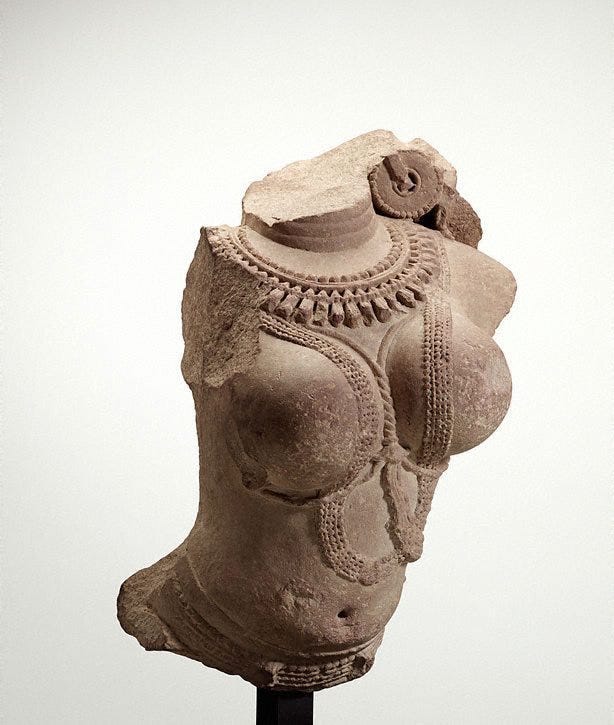The Indus Valley Seal: Proof That Mothers, Invented Civilisation Through Yoga
Before enlightenment, there was endurance. How the realities of pregnancy, labour and survival of the mother shaped the origins of yoga and the first civilisations
Let’s stop viewing ancient artefacts through the lens of modern culture. In pre-machine times — shaped by season and harvest — crafted objects held cultural significance. Seals from this period weren’t merely decorative, they referenced revered objects, animals or practices central to the culture — essential elements of life. Seals were a record of what mattered.
The Indus Valley Seal was made during a time when we all worshipped the Earth, not war.
Around 2500 BCE the Mature Harappan era. The Indus Valley was thriving. Often referred to as a cradle of civilisation, it spanned what is now modern-day Pakistan, northwest India and eastern Afganistan. Survial depended on fertility, not conquest. Reverence belonged to the earth’s cycles, not to the Iron Age Heros — they were still coming.
The seal shows a seated female figure with three faces — pre-empting Hecate, the Greek archytype of maiden, mother, and crone. It speaks of the rhythm of a woman’s life not in legend, but in pattern.
The Indus Valley Seal likely refernced an important teaching tool. A tool used in initiation conversations involving young women and elders — womens’ business.
These talks, common to many (if not all) indigenous societies, centre around the toughest transition of all. The one from maiden to mother - from carefree girl to both warrior and warhorse.
The seal, however, depicts a woman in her final transformation — the payoff — the wise woman or crone. She has recovered from the long drawnout campain of motherhood, she has regained her composure, over and over again — the lessons of mothehood have fortified her nervous system. Now parasympathetic impulses predominate, demonstrating a presence is so unmistakenly composed, that even the wild animals recognise her authority —
her breath settles them.
We know that Superman has a backstory — origin, struggle and transformation. But we meet him mid-flight, already powerful, arm thrust toward the sky.
The seal captures the same thing — a woman in her moment of power.
Like Superman, the journey and the years spent becomming are all left out of the frame.
However, its what’s embedded in her backstory — the unseen part nobody carved into picture of the Indus Valley Seal. The story of seed planting, growth, harvest, rebuilding and preparing the ground for the next crop.
This is the true root of civilization.

True crone — or wise woman — status is acheived a result of her journey. It is a reflection of the cycles of her life during motherhood — of bearing children and recovering in order to bear again.
She rebuilt what was stripped: iron and calcium, from blood and bone, strength and confidence from her core, breath regulation and parasympathetic predominance.
It’s not that men can’t do this. It’s not that men haven’t, at times, been students of this way. But she led — whether by example, by endurance or through conscuious reflection and active teaching. She knew she was leading.
Her life was the story. Her cycle embodied labor was civilisation - not its ornament but its origin.
1. Posture
Accompished from the Inside Out
Siddhasana —accomplished pose
Functional posture for elongating the breath
Promotes pH balance and facilitates cellular oxygenation
Restores parasympathetic predominance via breath regulation
Pelvic floor mirrors the diaphragm; this rocking action oxygenates core organs
2. Horns and Fountain
Likely before the formalised chakra system as we know it
Ajna —the twin horns or perception and inner vision
Horns symbolise maturity and natural authority
Sahasrara —fountain-like crown evoking the thousand petal lotus
Crown chakra of shared consciousness
She links and speaks for the voiceless: the very young and the very old
3. The Bangles as Accumulated Wisdom
Not adornment, but a tally
Rows of fives — markers of cyclical rebuilding
Female yogic mastery through repetition
4. The Ground Beneath Her: Agriculture and Order
Her throne is based on grain and dairy - soft power through cultivation
Mooladhara embodied: rootedness, repetition, survival
Woven mat beneath represents harvested grain: wheat or barley
Crouching animals are proto-cattle - kept for milk - not hunted
Symbols speak of storage, patience, seasonal return
She rests not on conquest but on cultivation
5. The Wild Beasts Tamed
Flanking animals symbolise integration, not domination
Under threat, she meets a sympathetic rise — a reflex to strike — with calm
Her steadiness settles the nervous system of those around her.
"Just as lions, elephants, and tigers are gradually brought under control, so the breath must be gently and consistently trained."
— Hatha Yoga Pradipika, II.15
This is what she has acomplished. Civilisation — the macro build from understanding her micro — the external order reflects what she has acheived within. Not by violence.
Through endurance and grit.
Her slow, grounded breath dominates. Not a show of power but through time, cycles: patience, perseverance and consistency.
The Indus Valley Seal is not metaphor. Not a God. It is practical instruction for those who would build a civilisation.
She is not performing, she is regulating. Not dominating. She was creating.




